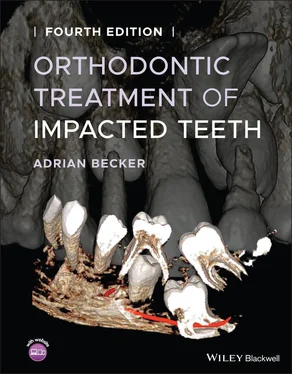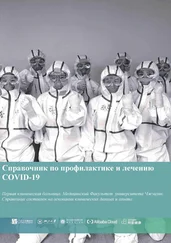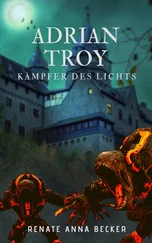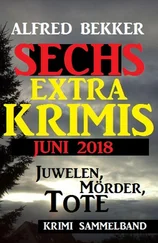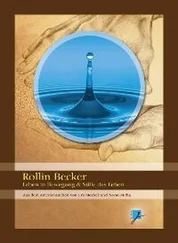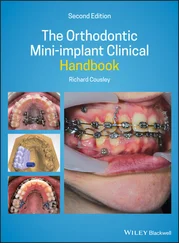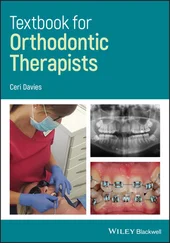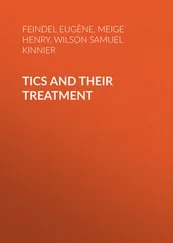2 Chapter 2 Fig. 2.1 Lasso wire encircling the neck of an impacted canine (circa 1971).... Fig. 2.2 Threaded pins set into prepared holes, drilled and tapped into the ... Fig. 2.3 As the impacted tooth is about to erupt, the high‐profile Siamese e... Fig. 2.4 Eyelets welded to a pliable band material base, backed by steel mes... Fig. 2.5 A direct tie using a very short length of elastic thread. Fig. 2.6 (a) The slingshot elastic. A palatally impacted canine has erupted ... Fig. 2.7 (a, b) The use of nickel–titanium auxiliary wire as the active elem... Fig. 2.8 An indirect anchorage system. (a) Extra‐oral view to show tipped oc... Fig. 2.9 Zygomatic plate. (a) An onplant plate. (b) The plate is held in plac... Fig. 2.10 The bonded magnet ‘backpack’.
3 Chapter 3 Fig. 3.1 (a) Buccal cantilever for extruding a canine. In practice, an eyele... Fig. 3.2 (a) The passive cantilever, made of rectangular wire, extends from ... Fig. 3.3 (a) For illustration purposes only, a combination of the beta‐titan... Fig. 3.4 (a) The biomechanical force system generated by a cantilever is a c... Fig. 3.5 (a, b) Ballista spring. The active configuration may differ in vert... Fig. 3.6 (a, b) Using an elastomeric chain is relatively simple and cost‐eff... Fig. 3.7 (a) Short vertical elastics exhibit a greater vertical component of... Fig. 3.8 (a) Sliding mechanics with a NiTi open‐coil spring threaded over a ... Fig. 3.9 (a) When aligning a high canine using a continuous and fully engage... Fig. 3.10 (a–c) Changing the position of the V bend will create totally diff... Fig. 3.11 (a) The passive configuration of the alpha–beta spring has to be m... Fig. 3.12 (a, b) A 0.016 in. main arch is combined with a 0.016 in. von der ... Fig. 3.13 When inverting a left upper canine bracket, it has to be kept in t... Fig. 3.14 The use of a Correx tension gauge is recommended to measure/contro... Fig. 3.15 Khouri Bendistal pliers are reliable tools for bending wire ends a... Fig. 3.16 The Sander Memory Maker allows NiTi wire adjustments in all planes...
4 Chapter 4 Fig. 4.1 The angle of the central ray in a true occlusal view of the lower j... Fig. 4.2 A diagram showing incisor inclination, receptor position and centra... Fig. 4.3 (a) The periapical view shows an impacted left maxillary central in... Fig. 4.4 The left periapical view, oriented for the central incisors, shows ... Fig. 4.5 A diagrammatic representation of the parallax method. If the observ... Fig. 4.6 The vertical tube shift method using a panoramic radiograph and per... Fig. 4.7 The lateral tube shift method using a panoramic radiograph and a la... Fig. 4.8 The enlarged premaxillary segment of a panoramic radiograph showing... Fig. 4.9 On the dry skull, the roots of the maxillary incisor teeth can be s... Fig. 4.10 (a) The true lateral cephalometric radiograph shows both canines s... Fig. 4.11 The true lateral and true occlusal views, taken together, provide ... Fig. 4.12 A dilacerated central incisor (arrow) seen in a lateral cephalomet... Fig. 4.13 Bone peeling in 3D. (a–d) Progressive bone peeling and how it may ... Fig. 4.14 A view of the multi‐planar reconstruction screen for Case 1, as pr... Fig. 4.15 Automatic segmentation, artificial intelligence (AI) driven. The s... Fig. 4.16 Diagnosing resorption, cross‐sections. The lateral incisor #12(7) ... Fig. 4.17 Diagnosing resorption with multi‐planar reconstruction. The long a... Fig. 4.18 Diagnosing resorption with multi‐planar reconstruction (MPR). The ... Fig. 4.19 Multi‐planar reconstruction for an incisor that is almost horizont... Fig. 4.20 First mandibular molar embracing inferior dental canal. (a) 3D bon... Fig. 4.21 Multi‐planar reconstruction view. Arrows indicate the invasive cer...
5 Chapter 5 Fig. 5.1 (a) A 16‐year‐old female exhibits an unerupted maxillary left canin... Fig. 5.2 (a) Soft tissue impaction of maxillary central incisors. (b) Apical... Fig. 5.3 Following exposure, attachment bonding and packing the unerupted to... Fig. 5.4 (a) A high buccal canine exposed by circular incision in the very w... Fig. 5.5 Crescini’s tunnel variation of the closed eruption technique. (a) A... Fig. 5.6 Cone beam computed tomography (CBCT) imaging slices of a palatally ... Fig. 5.7 Treatment for the right buccally impacted maxillary canine was perfo... Fig. 5.8 Treatment for the right palatally impacted canine was performed wit... Fig. 5.9 A case treated by the author in the mid‐1970s, before the era of th... Fig. 5.10 (a) The initial records of the dentition showing the narrowed V‐sh... Fig. 5.11 A case of bilateral palatal impaction of maxillary canine treatmen... Fig. 5.12 (a) Mild palatal displacement of the right maxillary canine locate...
6 Chapter 6Fig. 6.1 (a) Abnormal lip morphology, absence of philtrum and midline positi...Fig. 6.2 (a) Clinical views of a 9‐year‐old boy with a bulging ridge form du...Fig. 6.3 (a) The anterior intra‐oral view with teeth in occlusion and the un...Fig. 6.4 An abnormally sited central incisor, whose root apex is close to th...Fig. 6.5 (a, b) Frontal and occlusal clinical views of a patient with a dila...Fig. 6.6 (a) The anterior section of a lateral cephalogram shows the sagitta...Fig. 6.7 (a) An occlusal view of Johnson’s (modified) twin‐wire arch, to sho...Fig. 6.8 Impacted central incisors due to unerupted supernumerary teeth. (a)...Fig. 6.9 The development of maxillary canine ectopia adjacent to an impacted...Fig. 6.10 The tangential view shows severe labial displacement of the root o...Fig. 6.11 A ‘classic’ dilacerated incisor.Fig. 6.12 A diagram to show how a vertically directed force through the deci...Fig. 6.13 (a) An extreme rarity: bilateral classic dilacerations of both cen...Fig. 6.14 A diagrammatic illustration of the progressive alteration in the o...Fig. 6.15 Dynamic development of a ‘classic’ dilaceration. (a) A periapical ...Fig. 6.16 (a, b) The occlusal and anterior views of the maxillary dentition ...Fig. 6.17 (a) The initial malocclusion of the patient before commencement of...Fig. 6.18 (a, b) The initial diagnostic periapical radiograph and anterior s...Fig. 6.19 (a) A periapical radiograph showing partially completed crown deve...Fig. 6.20 (a) A 9‐year‐old child has lost alveolar bone height following tra...
7 Chapter 7Fig. 7.1 Periapical view of the maxillary canine area shows impaction of the...Fig. 7.2 (a) A 3D cone beam computed tomography (CBCT) view showing the apic...Fig. 7.3 Lingually displaced lateral incisors and buccally displaced maxilla...Fig. 7.4 (a, b) Periapical views of bilaterally impacted canines, each assoc...Fig. 7.5 (a) Panoramic view of a patient in the mixed‐dentition stage with a...Fig. 7.6 (a) Periapical view of normal incisors at age 3 years. Note the deg...Fig. 7.7 (a) In the early stages the unerupted canines are mesially directed...Fig. 7.8 Late‐developing dentition showing spacing, small peg‐shaped lateral...Fig. 7.9 Lateral incisor anomaly in patients with palatally displaced canines...Fig. 7.10 A series of periapical radiographs of an untreated girl, taken bet...Fig. 7.11 (a) Anterior section of a panoramic view of a 10‐year‐old boy with...Fig. 7.12 Panoramic view of a 12‐year‐old girl with a palatally impacted lef...Fig. 7.13 Odontoma causing impaction of the canine.Fig. 7.14 (a) Intra‐oral view of an 8‐year‐old child with an unerupted left ...Fig. 7.15 Maxillary canine/first premolar transposition. An example of bilat...Fig. 7.16 Despite the absence of crowding, the canine has erupted in an abno...Fig. 7.17 The left side of a case of bilateral hereditary primary tooth germ...Fig. 7.18 (a) Eruption status of the canine on the ipsilateral (affected) si...Fig. 7.19 A dentigerous cyst surrounds the crown of an impacted canine. Note...Fig. 7.20 Periapical view of maxillary incisor area in a 63‐year‐old female,...Fig. 7.21 The impacted canine crown is surrounded by a large dentigerous cys...Fig. 7.22 Palpable canines (a) labially displaced (arrow); (b) palatally dis...Fig. 7.23 (a) A panoramic view of the dentition of a boy aged 11 years, show...Fig. 7.24 (a) A case diagnosed from this panoramic view as exhibiting right‐...Fig. 7.25 (a) A case of early crowding treated by extraction of four deciduo...Fig. 7.26 (a) The left side of a case with bilateral maxillary palatal canin...Fig. 7.27 (a, b) A palatally impacted right canine was adjacent to the peg‐s...Fig. 7.28 (a–c) A class II, division 2 case with crowding in the maxillary a...Fig. 7.29 (a–c) Inadequate space for unerupted permanent canines with inter‐...Fig. 7.30 A standard preformed archwire illustrates the narrowed and flattene...Fig. 7.31 Creating space by distal movement. (a–e) The initial clinical view...Fig. 7.32 Bone support levels in the treated canines (light bars) compared w...Fig. 7.33 (a, b) Intra‐oral views of the initial condition. (c) View of the ...Fig. 7.34 Using an eyelet for eruption and rotation. (a, b) With the canine ...Fig. 7.35 The periapical view of an extreme example of group 2 canines. The ...Fig. 7.36 (a) The coil spring on the archwire had created space for the cani...Fig. 7.37 (a) The active palatal arch in its passive mode, lying several mil...Fig. 7.38 (a) Initial treatment had created space and a heavy base arch, car...Fig. 7.39 (a, b) With the eruption of the canine into the mid‐palate, the ey...Fig. 7.40 (a) The initial intra‐oral view of the teeth in occlusion. (b) The...Fig. 7.41 (a) A group 3 canine was exposed with an open procedure and healin...Fig. 7.42 (a) Minimal exposure and eyelet attachment bonding of the palatal ...Fig. 7.43 A case treated by the author circa 1972, using an approach recomme...Fig. 7.44 (a) Crescini’s ‘tunnel’ approach. Note the preservation of the buc...Fig. 7.45 Direct traction vs. two‐stage traction in the group 3 canine.Fig. 7.46 Acute periodontal pain from prematurely attempted buccal movement ...Fig. 7.47 (a) A group 3 canine exposed and viewed from the occlusal aspect t...Fig. 7.48 (a) The active palatal arch in place to erupt a group 4 canine tha...Fig. 7.49 (a, b) A maxillary canine/first premolar transposition, treated to...Fig. 7.50 (a, b) Canine/lateral incisor transposition seen intra‐orally and ...Fig. 7.51 Anterior, left side and occlusal screenshots from the video clip o...Fig. 7.52 (a) Intra‐oral views of a 12‐year‐old male with a left maxillary i...
Читать дальше
